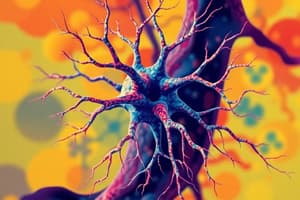Podcast
Questions and Answers
Which of the following describes the primary function of a sensory neuron?
Which of the following describes the primary function of a sensory neuron?
- To provide structural support and insulation to other neurons.
- To carry signals from the brain to muscles or glands.
- To detect stimuli and transmit signals to the central nervous system. (correct)
- To process information within the central nervous system.
A nerve is a single, isolated neuron that transmits electrical signals.
A nerve is a single, isolated neuron that transmits electrical signals.
False (B)
What is the role of a motor neuron in the nervous system?
What is the role of a motor neuron in the nervous system?
transmit signals from brain/spinal cord to muscles/glands
The ______ system uses hormones to relay messages through the bloodstream.
The ______ system uses hormones to relay messages through the bloodstream.
Match the following parts of a neuron with their function:
Match the following parts of a neuron with their function:
Where is the pituitary gland located?
Where is the pituitary gland located?
The thyroid gland produces insulin to regulate blood sugar levels.
The thyroid gland produces insulin to regulate blood sugar levels.
What is the function of the hormone thyroxine?
What is the function of the hormone thyroxine?
The adrenal glands produce ______, which is involved in the 'fight or flight' response.
The adrenal glands produce ______, which is involved in the 'fight or flight' response.
Match the following hormones with their primary functions:
Match the following hormones with their primary functions:
What process is primarily controlled by negative feedback loops in the human body?
What process is primarily controlled by negative feedback loops in the human body?
An increase in body temperature will always trigger mechanisms to further increase the temperature.
An increase in body temperature will always trigger mechanisms to further increase the temperature.
Name two organs involved in regulating blood glucose levels.
Name two organs involved in regulating blood glucose levels.
The ______ is responsible for regulating water and mineral salt concentrations in the body.
The ______ is responsible for regulating water and mineral salt concentrations in the body.
Match the following functions with their corresponding organ:
Match the following functions with their corresponding organ:
What is the role of the glomerulus in the nephron?
What is the role of the glomerulus in the nephron?
The ascending loop of Henle allows water to pass from the filtrate into the surrounding tissue.
The ascending loop of Henle allows water to pass from the filtrate into the surrounding tissue.
Name two substances that are reabsorbed in the first coiled tubule of the nephron.
Name two substances that are reabsorbed in the first coiled tubule of the nephron.
The collecting duct reabsorbs solutes and ______ from the filtrate.
The collecting duct reabsorbs solutes and ______ from the filtrate.
Match the following parts of the nephron with their PRIMARY function:
Match the following parts of the nephron with their PRIMARY function:
The primary function of the skin is:
The primary function of the skin is:
Erector muscles cause vasodilation when the body is overheating.
Erector muscles cause vasodilation when the body is overheating.
Aside from temperature regulation, list one other function of the skin.
Aside from temperature regulation, list one other function of the skin.
The outermost layer of the skin is called the ______.
The outermost layer of the skin is called the ______.
Match the skin structure with its primary function:
Match the skin structure with its primary function:
In type 1 diabetes, the body:
In type 1 diabetes, the body:
Most cases of type 2 diabetes cannot be prevented.
Most cases of type 2 diabetes cannot be prevented.
List three symptoms associated with type 1 diabetes.
List three symptoms associated with type 1 diabetes.
A potential warning sign for type 1 or type 2 diabetes is breath that smells similarly to ______.
A potential warning sign for type 1 or type 2 diabetes is breath that smells similarly to ______.
Match the risk factors with the appropriate type of diabetes.
Match the risk factors with the appropriate type of diabetes.
Flashcards
What is a Nerve?
What is a Nerve?
A nerve is a bundle of neurons.
What is a Neuron?
What is a Neuron?
A neuron, also known as a nerve cell, is a specialized cell that transmits electrical and chemical signals in the nervous system.
What is Epineurium?
What is Epineurium?
The epineurium is the outermost layer of dense irregular connective tissue surrounding a peripheral nerve.
What is Perineurium?
What is Perineurium?
Signup and view all the flashcards
What is Endoneurium?
What is Endoneurium?
Signup and view all the flashcards
What is Soma?
What is Soma?
Signup and view all the flashcards
What are Dendrites?
What are Dendrites?
Signup and view all the flashcards
What is an Axon?
What is an Axon?
Signup and view all the flashcards
What is a Myelin Sheath?
What is a Myelin Sheath?
Signup and view all the flashcards
What are Schwann cells?
What are Schwann cells?
Signup and view all the flashcards
What are Nodes of Ranvier?
What are Nodes of Ranvier?
Signup and view all the flashcards
What are Sensory Neurons?
What are Sensory Neurons?
Signup and view all the flashcards
What are Relay Neurons?
What are Relay Neurons?
Signup and view all the flashcards
What are Motor Neurons?
What are Motor Neurons?
Signup and view all the flashcards
Electrical impulses.
Electrical impulses.
Signup and view all the flashcards
What is a Synapse?
What is a Synapse?
Signup and view all the flashcards
What is the Spinal Cord?
What is the Spinal Cord?
Signup and view all the flashcards
What are Receptors?
What are Receptors?
Signup and view all the flashcards
What are Effectors?
What are Effectors?
Signup and view all the flashcards
What is The Nervous System?
What is The Nervous System?
Signup and view all the flashcards
What are Hormones?
What are Hormones?
Signup and view all the flashcards
What is The Endocrine System?
What is The Endocrine System?
Signup and view all the flashcards
What is the Pituitary Gland?
What is the Pituitary Gland?
Signup and view all the flashcards
What is the Pancreas?
What is the Pancreas?
Signup and view all the flashcards
What is Homeostasis?
What is Homeostasis?
Signup and view all the flashcards
What is Negative Feedback?
What is Negative Feedback?
Signup and view all the flashcards
What are the roles of The Skin, Liver, and Kidneys?
What are the roles of The Skin, Liver, and Kidneys?
Signup and view all the flashcards
What does the Kidney do?
What does the Kidney do?
Signup and view all the flashcards
What does the Nephron do?
What does the Nephron do?
Signup and view all the flashcards
What is Dialysis?
What is Dialysis?
Signup and view all the flashcards
Study Notes
Structure of a Nerve
- A nerve is a bundle of neurons
- The structure includes the epineurium, perineurium, and endoneurium
- Nerves consists of blood vessels, supplying nerve(vasa nervorum)
- Fascicles are also present
- Peripheral nerves can be myelinated and non-myelinated
Structure of a Neuron
- Neurons contain dendrites and a soma (cell body)
- Neurons contain an axon, myelin sheath, and a nucleus
- At the end of the neuron is a nerve ending
- Some neurons contain Schwann cells
Types of Neurons
- Sensory neurons contain a receptor cell, cell body, axon, and myelin sheath
- Relay neurons contain dendrites, cell body, and an axon
- Motor neurons contain a cell body, Nodes of Ranvier, Schwann cells, and axon
Nervous System
- Electrical impulses act as messengers in the nervous system
- Key structures include the brain, spinal cord, peripheral nervous system, ganglion, and nerves
Endocrine System
- Hormones are the chemical messengers
- Hormones target cells in the endocrine system through the bloodstream
- Key examples of Endocrine glands are the pineal gland, pituitary gland, thyroid gland, thymus, adrenal gland, pancreas, ovaries (female), and testes (male)
Sensory Mechanism
- Sensory neurons, relay neurons, and motor neurons are all involved in the sensory mechanism
- The spinal cord contains grey and white matter
- The central nervous system coordinates a response
The Eye and Focus
- Key structures of the eye include the suspensory ligament, sclera, cornea, iris, pupil, lens, ciliary muscle, retina, fovea, and optic nerve
- To focus on near objects the ciliary muscle contracts, suspensory ligaments slacken, and the lens becomes fatter.
- To focus on distant objects the ciliary muscle relaxes, suspensory ligaments contract/stretch, and the lens becomes thinner
Hormone Production
- The pituitary gland is the 'master gland', situated at the base of the brain
- The thyroid gland produces thyroxine
- The pancreas produces insulin and regulates blood glucose levels, as well as digestive enzymes such as pancreatic amylase and lipase
- The adrenal glands produce adrenaline
- The testes produce testosterone (male sex hormone)
- The ovaries produce oestrogen (female sex hormone)
Hormones and Target Cells
- Hormones bind to specific receptors on target cells
- Non-target cells do not have a receptor for that particular hormone
- Some of these cells make and secrete the hormone
Homeostasis
- Homeostasis is the maintenance of a stable internal environment
- This involves several components input sent, control centre, receptor, output sent, effector, change detected, imbalance (stimulus), response to change and imbalance corrected
- The normal body temperature is around 37° C, and the body is composed around 70% water
Negative Feedback Loop
- Kidneys regulate water & mineral salts concentration
- Skin regulates body temperature
- The liver & pancreas regulate blood glucose level
Insulin and Glucose Regulation
- Beta cells of the pancreas release insulin at high blood glucose levels
- Insulin triggers body cells to take up glucose from the blood promoting cellular respiration
- Glucose is removed from the blood and stored as glycogen in the liver
- Alpha cells of the pancreas release glucagon at low blood glucose levels
- Glycogen in the liver is broken down into glucose and released into the blood
Type 1 Diabetes
- Symptoms include weight loss, frequent urination, irritability, blurry vision, and fruity breath
Type 2 Diabetes
- The body cannot use insulin properly
- Can develop at any age
- Most cases can be prevented
- Risk factors include: being overweight, having a family history and having diabetes while pregnant (gestational diabetes)
- Can be prevented or delayed via weight loss, eating healthier, and being more active
- Can be managed by working with a health professional, eating healthy and staying active
Skin
- Structure of Mammalian Skin consists of the epidermis, dermis, hair follicle, sebaceous gland, arrector muscle receptors, subcutaneous fat, nerve fibres, and blood capillaries
- The skin also contains sweat glands
Waste Substances
- Excess hormones, water and Salt/lons (Na+, Cl-, Mg+, Ca2+, HCO3-) are considered waste substances
- Urea, creatinine, and ammonia are also considered waste products
The Kidney Structure
- Internal structures include cortex, medulla, renal pelvis, fibrous capsule, branch of renal vein and branch of renal artery and the ureter
Nephron
- The nephron contains; a glomerulus, Bowman's capsule, proximal tubule, distal tubule, and collecting duct
- It also contains he ascending/descending Loop of Henle, afferent & efferent arteriole
Kidney Function
- Glomerulus filters small solutes from the blood
- 1st coiled tubule reabsorbs ions, water, removes toxins and nutrients
- The descending loop of Henle is where water is allowed to pass from the filtrate into 2nd tubule
- The ascending loop of Henle reabsorbs Na+ and Cl- from the filtrate
- 2nd tubule selectively secretes & absorbs different ions to maintain pH/ electrolyte
- Collecting duct reabsorbs solutes and water from the filtrate
Dialysis
- A dialyser is used to filter blood
- Clean blood is returned to the patient
- Used dialysis fluid contains the removed waste
Studying That Suits You
Use AI to generate personalized quizzes and flashcards to suit your learning preferences.




